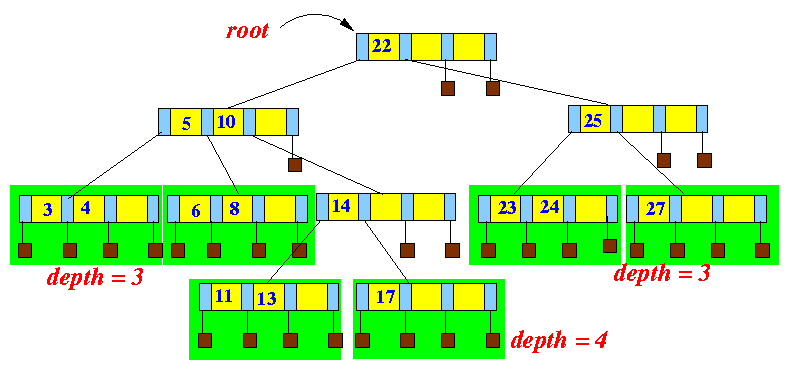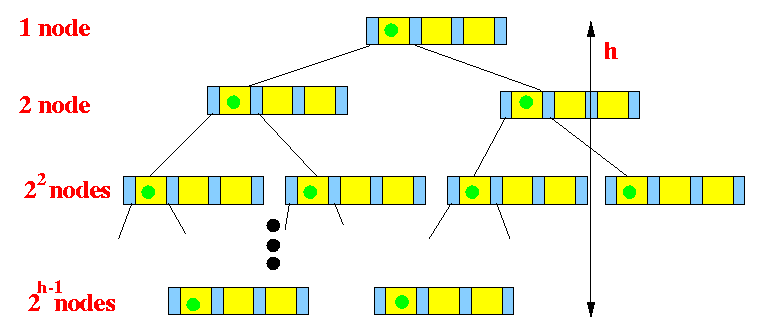- Other names for the (2,4)-tree:
- 2-4 tree
- 2-3-4 tree
- Properties of the (2,4)-tree:
- Size property:
- Each node has
exactly 4 (internal/external)
children nodes:
- Each internal node
has
2-4 (i.e,: 2, 3 or 4) subtrees
- Each external node has 0 subtrees
- Each internal node
has
2-4 (i.e,: 2, 3 or 4) subtrees
- Each node has
exactly 4 (internal/external)
children nodes:
- Depth (height) property:
- Let E be
the set of internal nodes
which only have
external children nodes
(I call these nodes: leaf nodes)
- All node
of E
must have the
same height (depth)
- All leaf nodes in a 2,4-tree has the same height !!!
- Let E be
the set of internal nodes
which only have
external children nodes
- Size property:
- Example: this tree is
not
a (2,4)-tree:

Because:
- The shaded nodes
has no children nodes
(i.e., leaf nodes)
- These nodes have
different heights:
- Some of these nodes have height = 3
- Some of these nodes have height = 4
- The shaded nodes
has no children nodes
(i.e., leaf nodes)
- Example: the following tree
is a good
(2,4)-tree:

Because:
- The shaded nodes
has no children nodes
(i.e., leaf nodes)
- All these nodes have the same height !!!!!!!!
- The shaded nodes
has no children nodes
(i.e., leaf nodes)
- Proposition 10.8 (Goodman)
- The height of a (2,4)-tree containing n entries is O(log(n))
Proof:
- Consider a (2,4)-tree that is
maximally populated with entries
(i.e., each internal node
has 3 keys (4 subtrees)

- The largest possible
number of entries stored in a
tree of height h is:
# nodes = 1 + 4 + 42 + 43 + ... + 4h-1 4h - 1 = --------- (Mathematica: Sum[ 4^k, {k,0,(h-1)} ]) 3
Max. # keys = 3 * # nodes = 4h - 1
Therefore: n ≤ max. value for n (# keys) ≤ 4h - 1 <==> n+1 ≤ 4h <==> 2log(n+1) ≤ h*log(4) <==> 2log(n+1) ≤ 2*h <==> ½ 2log(n+1) ≤ h ........ (1)
- Now consider a (2,4)-tree that is
minimally populated with entries
(i.e., each internal node
has 1 keys (2 subtrees)

- The smallest possible
number of entries stored in a
tree of height h is:
# nodes = 1 + 2 + 22 + 23 + ... + 2h-1 = 2h - 1 (Mathematica: Sum[ 2^k, {k,0,(h-1)} ])
Min. # keys = 1 * # nodes = 2h - 1
Therefore: n ≥ min. value for n (# keys) ≥ 2h - 1 <==> n+1 ≥ 2h <==> 2log(n+1) ≥ h*log(2) <==> 2log(n+1) ≥ h ........ (2)
- From Equations (1) and (2),
we conclude that:
2log(n+1) --------- ≤ h ≤ 2log(n+1) 2Therefore:
- h = O(log(n)) Q.E.D.
- The search operation
for a (2,4)-tree is
bounded by the
height of the (2,4)-tree
- Therefore:
- Worst case runing time of searching in (2,4)-tree = O(log(n))
- There are many
other types of
multi-way search trees
Common property:
- All of them are balanced
(I.e., nodes with no children are all of the same height)
- All of them are balanced
- A commonly used type of
multiway search tree is the
B-tree
("B" is not for "binary", nobody knows,
some suspects it stands for "Boeing")
- Rudolf Bayer
and Ed McCreight
invented the B-tree while
working at Boeing Research Labs
in 1971 (Bayer & McCreight 1972),
but they did not explain what, if anything, the B stands for.
Wikipedia: click here
- Rudolf Bayer
and Ed McCreight
invented the B-tree while
working at Boeing Research Labs
in 1971 (Bayer & McCreight 1972),
but they did not explain what, if anything, the B stands for.